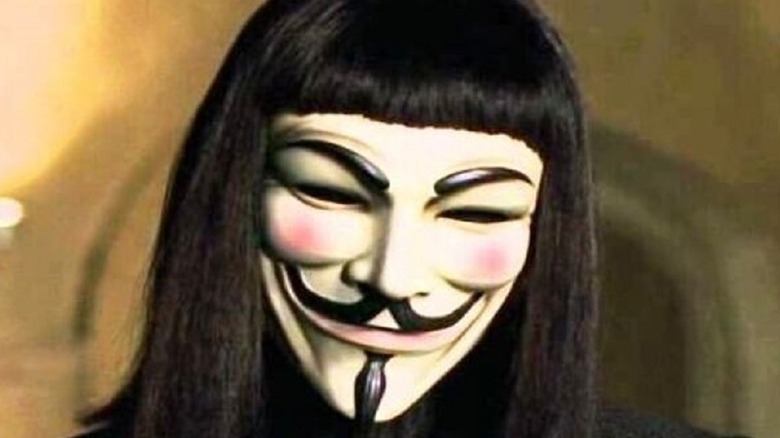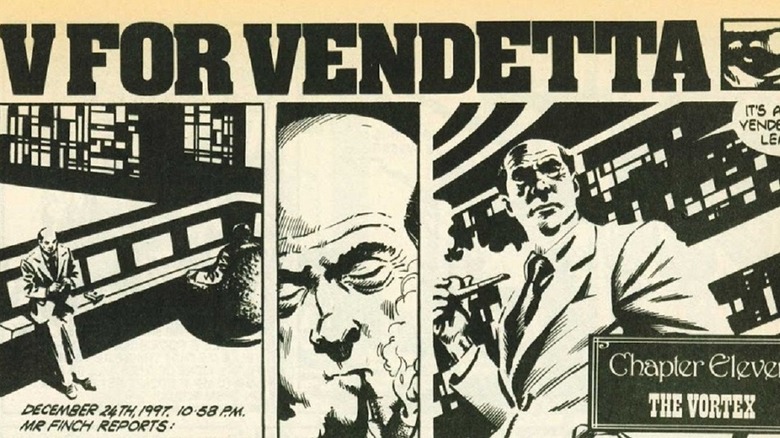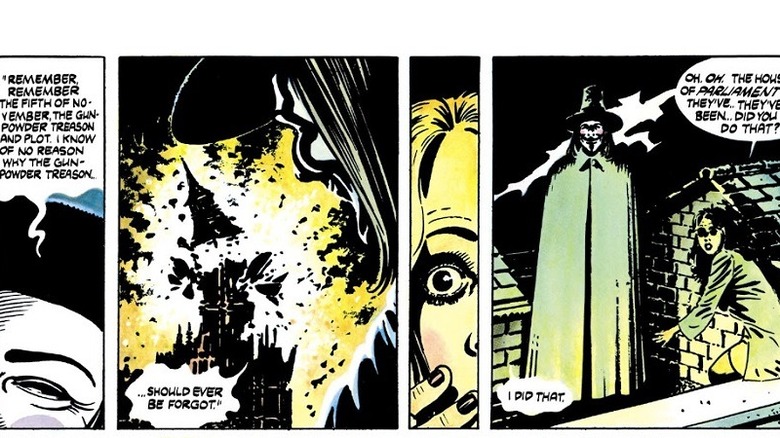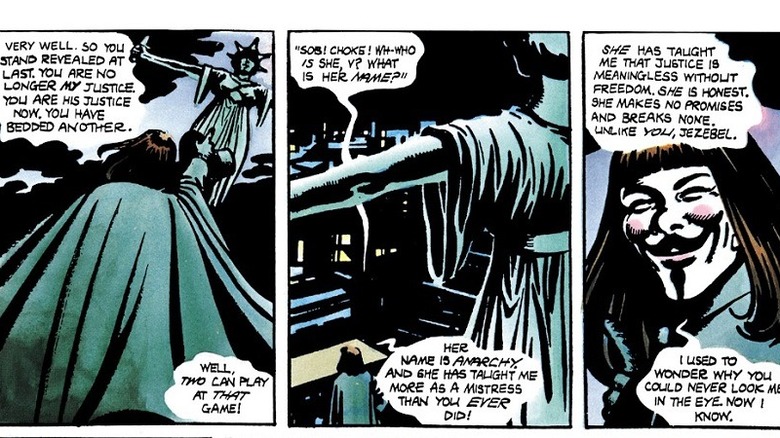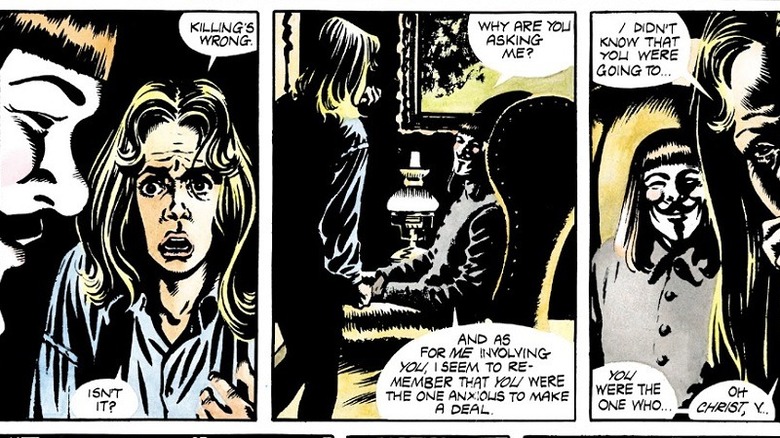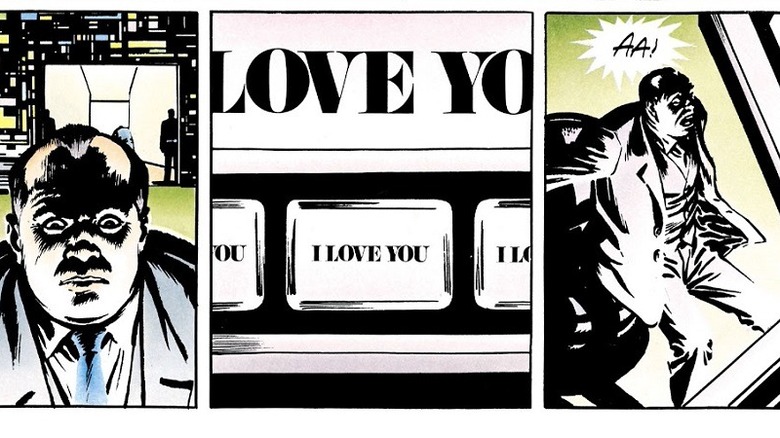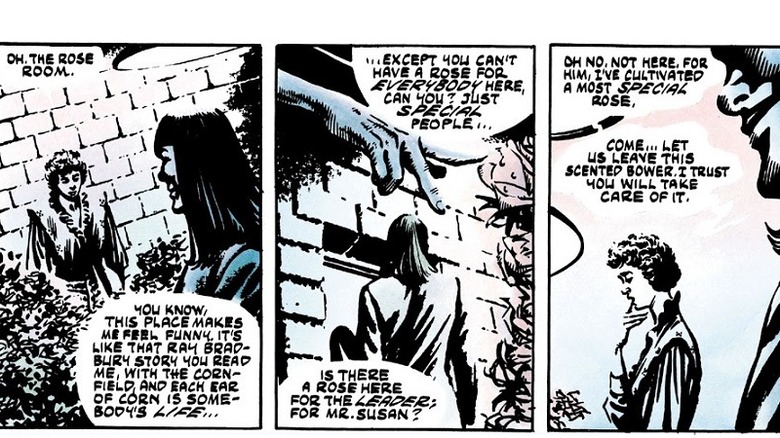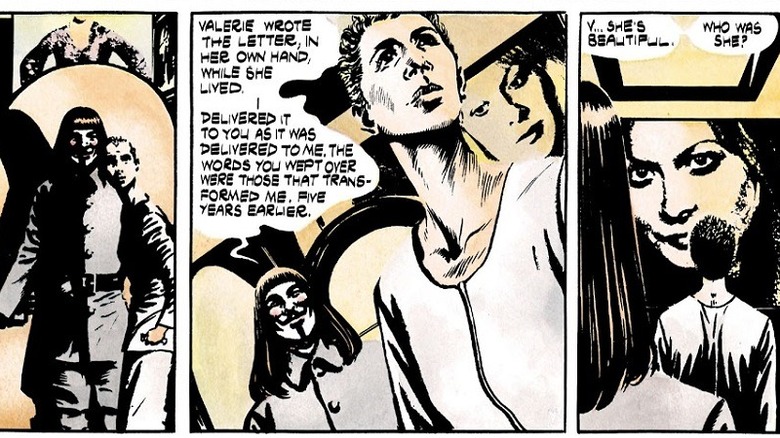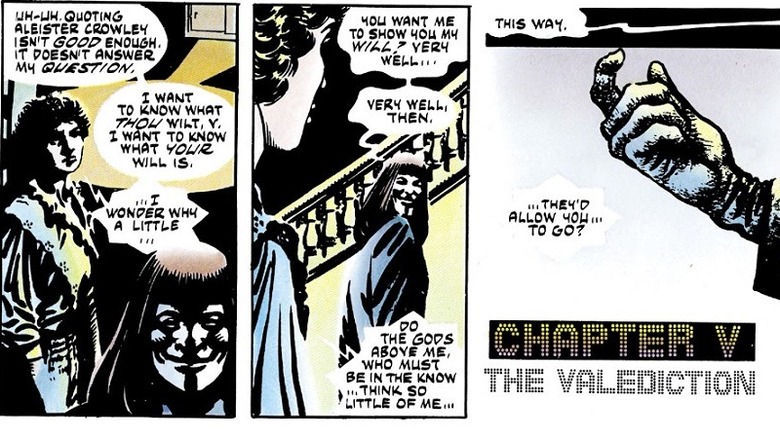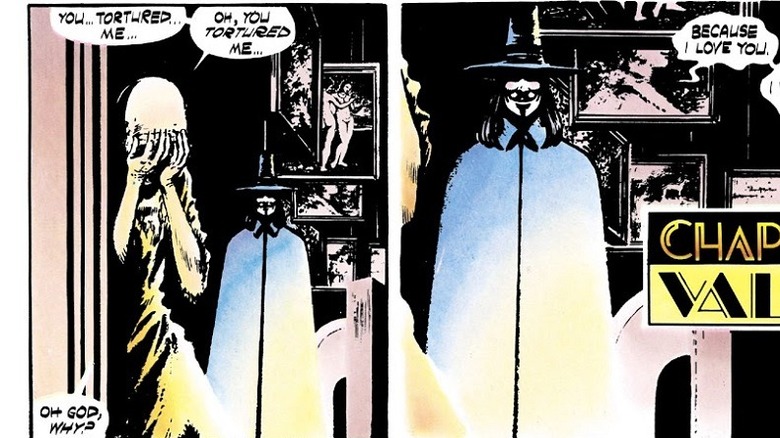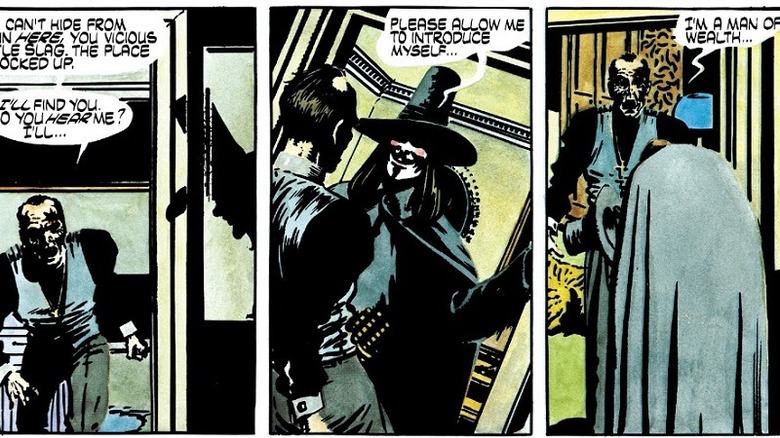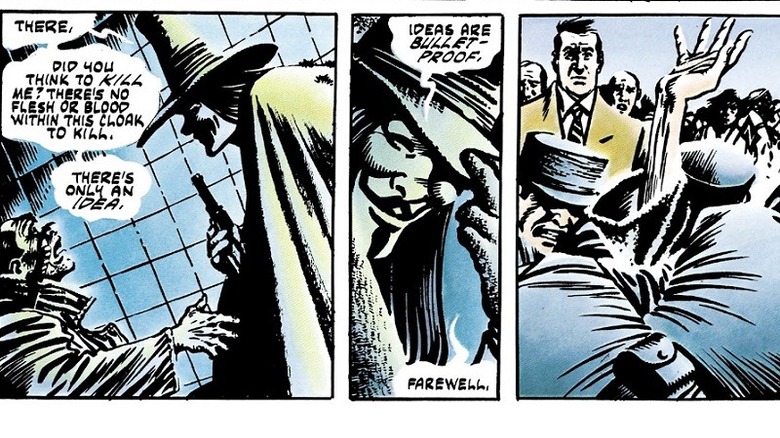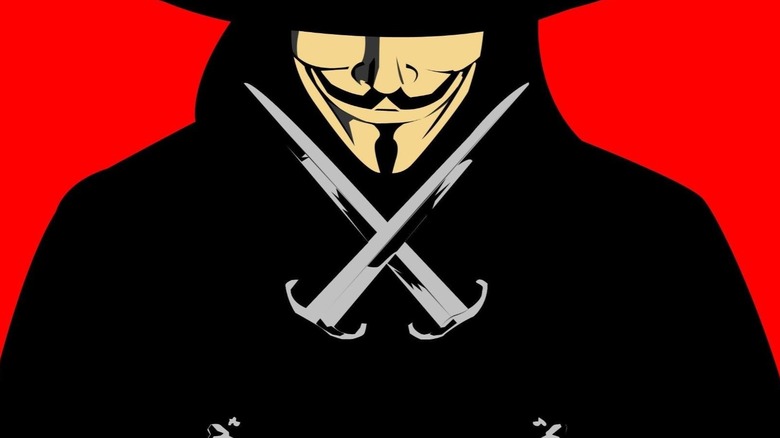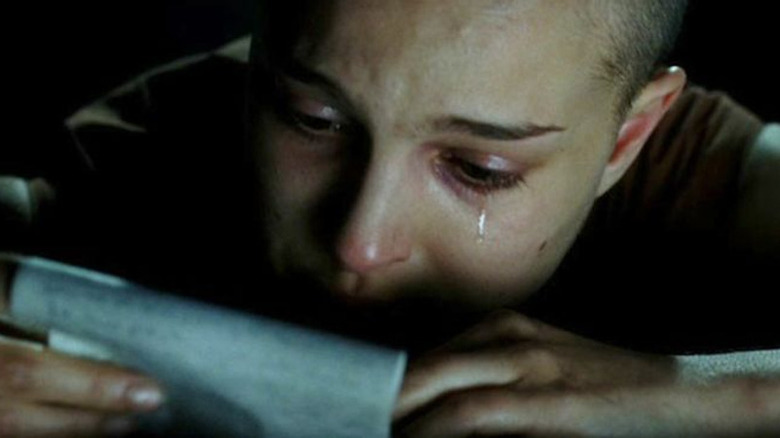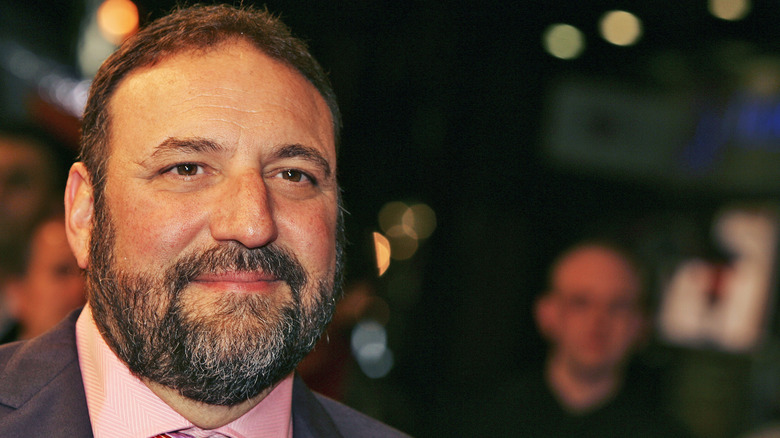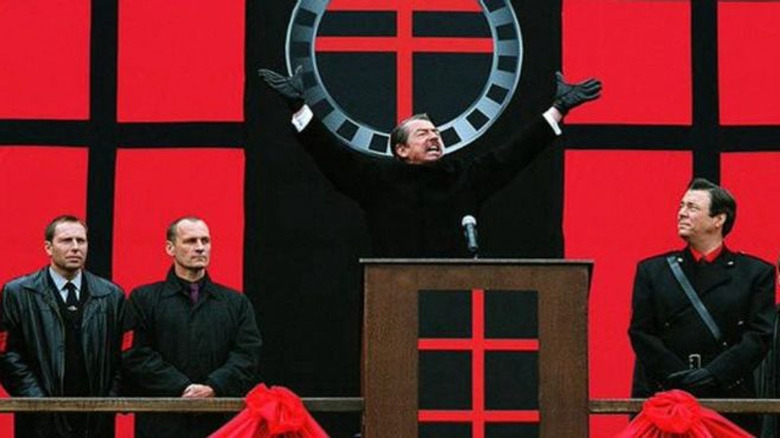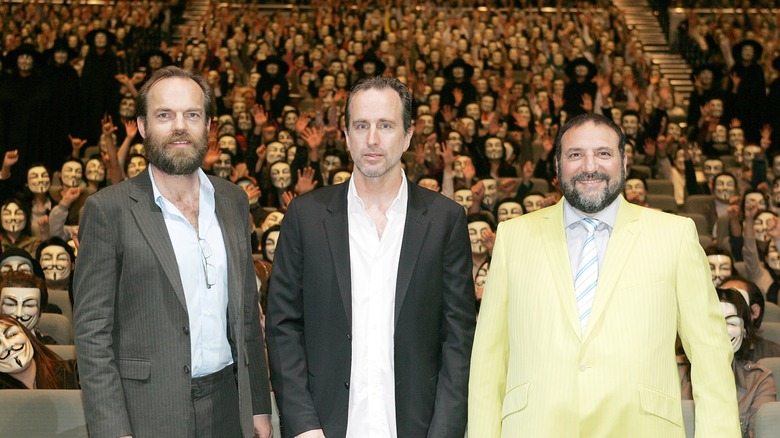The Untold Truth Of V For Vendetta
Alan Moore and David Lloyd began the "V For Vendetta" graphic novel in 1982. Published in short chapters in a British anthology, it features the dark, fascist future of 1997 England after a limited nuclear war crippled much of the rest of the world. England was spared the worst, but a far-right government coalesced around the Norsefire party, a white supremacist group that killed people of color and queer individuals in short order. The story opens with 16-year-old Evey Hammond clumsily soliciting herself as a prostitute, only to find that she'd solicited a cop (known as the "fingermen").
The police are set to assault and murder Evey before a strange man in a smiling mask gasses and kills them using highly theatrical and elaborate methods. Saving her life, he takes her to his home, which he calls the Shadow Gallery. The man has no name, but says that she could call him V. Then he blows up the Houses of Parliament, much as Guy Fawkes once tried to do. This sets off an elaborate story surrounding a morally ambiguous protagonist, his mysterious plans, and Moore's own treatise on anarchism as a philosophy. It was also personal, as he saw signs of fascism creeping into England's present and future (via COMICON).
In 2005, a film adaptation of "V for Vendetta" written by the Wachowskis and directed by James McTeigue released. Let's explore the stories behind both the comics and the movie.
From Warrior to DC Comics
During the early '80s, UK publisher and editor Dez Skinn left Marvel U.K. and started his own imprint, Quality Communications. In 2004, he told Ninth Art that he invited artist David Lloyd to do "... a detective noir type story. I had worked with Alan [Moore] on 'Dr. Who,' and so I asked him if he'd get involved with 'V For Vendetta.' ... He had something more heroic in mind for V, but Alan took it and made it more theatrical."
The first chapter appeared in Skinn's new anthology, "Warrior." Moore started "Marvelman" in the same issue, a strip that eventually became "Miracleman." Moore wanted to incorporate a lot of themes, including riffs on George Orwell, Aldous Huxley, Thomas Pynchon, "The Prisoner," and many other cultural touchstones. Each issue featured a single chapter, and the storyline was organized into three separate books. Book one was "Europe After The Reign," a pun on an apocalyptic painting by Max Ernst. Book two was "This Vicious Cabaret," a song that V performed that was actually released as a record. "Warrior" ran for 26 issues, and "V For Vendetta" ran in every issue but one. The last two chapters of book two were set to appear in #27 and #28, but they were never published.
DC Comics picked up the series, added color, and released the books as ten single issues before they were collected. The third book, "The Land Of Do-As-You-Please," came from Enid Blyton's "The Faraway Tree" series of books. The final issue was published nearly seven years after the first story appeared.
V's Guy Fawkes mask as a symbol of protest
V uses a Guy Fawkes mask and wears a wig to conceal his identity. His first major act is destroying the Houses of Parliament on November 5, 1997. Guy Fawkes was a Catholic conspirator who sought to destroy Parliament by packing it full of gunpowder and blowing it up. He was arrested before he could carry it out, and the "gunpowder plot" became a patriotic rallying point. The film version even depicts Fawkes doing this in order to introduce the image of his mask. Historically, Guy Fawkes day was celebrated to burn Fawkes in effigy, which is where the masks originated.
Moore subverted this idea when he had V destroying these buildings, and David Lloyd made effective use of this frozen, smiling face throughout the book. The film inspired a number of people to don the mask in various forms of protest. Ironically, Time Warner owns the rights to the image and profits with each mask sold (per The New York Times). The hacker collective Anonymous uses the Guy Fawkes mask as a disguise for its activities, which have included cyber attacks on the CIA, KKK, the Church of Scientology, and various corporations.
The mask was also frequently seen during the Occupy movement and protests in Hong Kong, protecting identities while symbolizing protest.
The comic and film explore different themes
Alan Moore made his disdain for the movie version of "V For Vendetta" clear during an interview with MTV. "[The comic] was specifically about things like fascism and anarchy," said Moore. "Those words, 'fascism' and 'anarchy,' occur nowhere in the film. It's been turned into a Bush-era parable by people too timid to set a political satire in their own country ... It's a thwarted and frustrated and perhaps largely impotent American liberal fantasy of someone with American liberal values [standing up] against a state run by neo-conservatives — which is not what 'V for Vendetta' was about."
Moore's interest in anarchism was highly-developed, grasping it in its most basic sense: not a lack of order, but an absence of leaders (per Infoshop News). "V For Vendetta" was an experiment in V understanding that the conditioning of a fascist state in particular has to be stripped away before its people can choose their own way. Moore's understanding of this was taking responsibility for one's own actions as well as acknowledging that "they are acting in a wider group."
The ending of the film, which is essentially one big protest with people wearing Guy Fawkes masks, seems to confirm the idea that it was less about the total destruction of a fascist state to build something anew and more about the importance of direct action in a democracy, which is at the heart of liberalism. When V dies at the end, Finch asks Evey his true identity, to which she replies, "He was all of us."
V's moral code is highly questionable
Alan Moore has frequently written protagonists who are not heroes, even if they are highly charismatic and carry much of the narrative. Rorschach in "Watchmen" and William Gull in "From Hell" are two of the more obvious examples, but this is definitely true of V as well. Even if Moore had an interest in anarchism, Moore deliberately makes the morality of V's actions ambiguous.
First and foremost, V is an unrepentant killer. He murders dozens of people who worked at the concentration camp at which he was imprisoned and tortured. Part of this was to erase his identity, but he takes special pleasure in poisoning the Bishop and driving Lewis Prothero insane, just as V had been driven by the drugs he was forced to take as part of an experiment.
Second, V is a cold manipulator. With the knowledge he gained from Fate and its vast surveillance network, he uses his own intuitive psychological skills to manipulate people to do what he wants. He pushes Rose Almond to murder the Leader. He pushes Conrad to murder the man who had been sleeping with his wife. Worst of all, he manipulates Evey several times in the guise of "freeing" her from her own prisons. In the first chapter, titled "The Villain," V quotes "Macbeth," only he positions himself as the rebel and the villain as he murders several Fingermen. V is in touch with his own morality enough to understand that he's lost his soul.
V destroys Norsefire using its own supercomputer
The plot of "V For Vendetta" doesn't have a lot of tension because V always seems one step ahead of his fascist opponents somehow. He is always vague about how he knows where his enemies are going to be, what they are doing, and what their weaknesses are. The Norsefire government sealed its own death warrant with their extensive use of surveillance and wiretapping, because V figured out how to hack their systems long ago.
There's a sense in which "V For Vendetta" is really one long denouement, or as V himself demonstrates, the tipping of a single domino for a course that took a great deal of time to prepare. After hacking into the Fate computer and its cameras, he spends years observing his opponents and devising plans for disposing of all of them. He only directly kills those who know his true identity, because he wants them to know who he is. For most of the others, he manipulates people into doing his own dirty work, correctly predicting that they will all act on their basest instincts.
V's most ingenious triumph is over the Norsefire Leader, Adam Susan. The erratic loner quietly professes his love to Fate on numerous occasions, and V messes with his head by having Fate tell Susan that she loves him too. That causes Susan to crack, leaving him vulnerable to assassination.
V's 'special rose' for Adam Susan
V's plots are absolutely byzantine and frequently cruel. Rose Almond was the wife of Derek Almond, the head of the Fingermen. Unsurprisingly, Derek was abusive toward his wife, hitting and demeaning her, as well as terrorizing her with a gun. Almond rushes out when he is told where V is going to strike next, and V kills him.
Rose winds up with Almond's rival, Roger Dascombe. She hates the idea of being with a sleaze like him, but she is denied government benefits and has nowhere else to go. Dascombe, the head of Norsefire's propaganda arm, the Mouth, is shot to death by government agents after V ties him up and puts his mask and hat on him, leaving Rose nowhere to go once again.
Rose joins a burlesque act to survive. The circumstances of her life keep pushing her from frail victim to something far more vengeful. V grew roses in his garden, and when he plucks one for somebody, it means he is going to kill them. He even offers Rose a stem for the man who killed her lover, but she refuses it. When asked about the Leader, V tells Evey that he had "cultivated a most special rose" for him, but not one in the garden. This ends up being Rose Almond, who acquires a gun and shoots the leader.
Valerie plays a key role in both the comic and film
The emotional climax of the graphic novel and movie arrives when Evey is taken by what she thinks are government forces and tortured, humiliated, and questioned. In the midst of all this, she receives a letter, hand-written on toilet paper, from the cell next door. It is from a woman named Valerie. A working actress who happens to be a lesbian, she was just starting to achieve success and was in a loving relationship when the war came. Norsefire took over, and she was rounded up and imprisoned. The letter urges not to let go of one's integrity, that it is the one thing that can't be taken away. It is also a moment of connection in an environment of total desolation. It helps give Evey the courage to resist collaboration.
While the entire situation is a set-up by V designed to get Evey to overcome her fears and transform the way he did, the letter is real. It was written by a woman named Valerie in Room IV. She sent V the note, and it gave him the push he needed to claim his own integrity and fight back. He planted roses in her honor (because she wrote about her partner giving her roses for Valentine's Day) and tracked down posters and copies of her films. She was V's central link to his own humanity, and she became Evey's way of valuing her own integrity over everything — including her own life.
Vs are everywhere
In the Parkhill Resettlement Camp, the concentration camp where people of color, queer folk, and radicals were shipped off to, a select number were chosen for "medical experiments." Mostly, a scientist wanted to see what would happen when people were injected with an experimental drug. It killed all of them eventually. Everyone except for one patient: the man in Room V.
Though completely insane, the survivor was also a genius, coming up with new ways to grow food. As such, they kept ordering the supplies he requested. One night, he revealed his endgame: he turned the supplies into mustard gas and napalm, killing dozens during his escape. He no longer had a name, and when he introduced himself, he told people to call him "V" — an identity he took to the extreme.
V's headquarters are located under the defunct Victoria underground station, one of only two stations in London that start with "V." He is drawn to vaudeville. He uses Beethoven's Fifth Symphony to drown out a conversation, the first five notes of which spell out "V" in Morse code. Every chapter of the comic starts with "V," from the introductory "The Villain" to the concluding "Valhalla." V quotes from the Thomas Pynchon novel "V.," which is about a man obsessed with a mysterious person known only as "V."
Evey and V's movie relationship takes a different turn
Apart from the divergent themes, the main difference between the film and comic versions of "V For Vendetta" is the relationship between V and Evey Hammond. In the comic, Evey is a naïve 16-year-old with no education. In the film, Evey is an employee of the British Television Network (the Mouth in the comic). In both cases, V rescues her from vicious Fingermen.
Emotionally, the comic version of V is a kind of surrogate father for Evey, but he is also cruel to her. He always does it in a way that he calculates will help make her his ideal replacement, but he still manipulates her into helping murder the Bishop, abandons her on a street when he knows it is time for her to live life as an adult, and then kidnaps and tortures her to achieve the same kind of liberating, transformational experience he had.
In the film, the relationship between V and Evey is more romantic in nature. However, he still kidnaps and tortures her for similar reasons. The political jumble makes this relationship make a lot less sense. V wants someone morally pure to take his place, someone whose choices aren't rooted in violence. In the film, everyone gets a Guy Fawkes mask, and Evey's role is far less important.
V's devilish references
In V's carefully-designed crusade to kill or leave comatose everyone who knows his true identity, his second victim is Bishop Anthony Lilliman, who was present at the Larkhill concentration camp where V was imprisoned. Lilliman is also a pedophile, who happily preaches about God and England every Sunday while the state sponsors and enables his horrific appetite.
When Evey volunteers to help V, he uses her as bait for the Bishop. She distracts him while V slips in. V uses this as an excuse for a series of riffs on god and the devil, positioning himself as the latter. After Evey scratches the Bishop to avoid his advances, V pops up and says, "Please allow me to introduce myself ... I am a man of wealth and taste." That's the famous first line from the Rolling Stones song "Sympathy For The Devil," wherein Lucifer recounts history from his perspective. V doffs his hat, revealing two devil horns sprouting from under his wig.
When Lilliman recognizes V, he shouts, "Who are you really?" V replies, "I am the devil, and I come to do the devil's work." A similar line was reportedly spoken by Charles Denton "Tex" Watson Jr., a Manson family associate, on the night of the Sharon Tate murders. V then asks about communion and the concept of transubstantiation, wherein the communion wafer is transformed into the body of Christ. Feeding the Bishop a cyanide-laced wafer, it is still cyanide when it reaches his stomach.
V knows there isn't a place for him in the new world
V knows that he is a killer that has chosen destruction. He doesn't see another way to bring down the fascist order. However, it is strongly implied that it would be all too easy for him to simply insert himself as a new leader — the last thing he wants. Just as he manipulates the deaths of so many others, he manipulates Nose detective Eric Finch into killing him. V knows that he has no role in the new world, but the symbol of what V represents is important. That's why he grooms Evey to be his replacement, one who isn't stained as a murderer and whose integrity is also impeccable.
As he tells Finch when he is shot, "Ideas are bulletproof." It seems perhaps like a bit of bravado, but it is also true. V creates a new persona, a new symbol, that now exists outside of himself. He tells Evey, "You must discover whose face lies behind this mask, but you must never know my face." Evey realizes he meant that his actual identity is irrelevant, because it is now her face behind the mask.
David Lloyd on the movie's aesthetics
Alan Moore was the writer of "V For Vendetta" and David Lloyd the artist. Both had rather divergent feelings about the film. Lloyd was supportive of the film and pleased by the result. In particular, he was impressed by the attention to detail in trying to make the movie look a lot like the comic. "They used the original graphic novel as storyboards, practically. That's what James (McTeigue, director) and Joel (Silver, producer) have been saying," he explained. "Owen Paterson, the designer, was concerned about getting things looking exactly like the original."
Regarding the changes the director made, Lloyd thought it "all turned out really well" and said he understood that alterations were made because they "had to abbreviate what was being said." However, he thought the film's message, "the central core of it all," which included "all the key instants ... and the philosophy behind it" was "all there." He disagreed with Moore, who thought the film's message warped the original source material.
David Lloyd's favorite movie scene
As an artist, David Lloyd was particularly keen to discuss the visual aspects of the film version of "V For Vendetta." He was especially impressed by the work of Adrian Biddle, the cinematographer, saying "It's really extraordinary seeing something that you've created come to life like that," and recalling enjoying the first reveal of V's Shadow Gallery. The scene he thought bore the closest resemblance to the original was the "transformation scene between Hugo Weaving and Natalie Portman where she comes out of that jail to find out that V is her torturer and they go through that moment, that kind of epiphany."
For Lloyd, drawing something as close to real life in the comics was important to him. Seeing it on film, he said, was "just like seeing one of your paintings come to life." Lloyd added that much of the film felt faithful to his original art, but "that is the one that really stands out for me. I think that speaks volumes to me about the dedication of the filmmakers to the original work."
Alan Moore was deceived
Alan Moore's disdain for all of the film adaptations of his comics is well known. He rejects the very concept of TV or film adaptations, saying "just because something worked as a comic book, that didn't mean you should make it into a film or a television series or a whole franchise."
Moore's reaction to his works being adapted has always been twofold: removing his name from the film and distributing any money made to the artists who worked on it. However, his requests were frequently ignored. "Out of the blue, I got a phone call from one of the [Wachowskis]," he recalled. "I tried to be as polite as possible ... and told him that I didn't want anything to do with the 'V For Vendetta' film." Pressed for a follow-up conversation, Moore demurred, saying he was too busy with other work to talk.
Moore went on to say a friend had told him that in the press, producer Joel SIlver had claimed that Moore was excited about the film and was working directly with the Wachowskis. Moore wryly noted that while the studio respected his request to not get paid, "the side of the deal where I actually got what I wanted, which was utter non-involvement with these films, that somehow didn't seem to have worked out."
Alan Moore on his characterizations
In discussing writing "V For Vendetta," Alan Moore specifically talked about fleshing out every character, even the villains. He said, "I was very pleased with the characterizations in 'V For Vendetta.' There's quite a variety of characters in there and they've all got very distinctive characteristics." That was true of even the most despicable characters, which was important to Moore because they felt "emotionally credible" to him — he didn't hate any of them. This was important because he thought writing about fascists as "cartoon Nazis ... with funny monocles and cigars and accents" would do little to establish just how commonplace and easy it is for fascism to arise. "Whereas in fact," he added, "fascists are people who work in factories, probably are nice to their kids, it's just that they're fascists. They're just ordinary. They're the same as everybody else except for the fact that they're fascists." Understanding them as real people might help the audience "learn something that was useful about them."
James McTiegue on the film's creation and legacy
"V For Vendetta" was director James McTiegue's first film at the helm after assisting the Wachowskis with the "Matrix" franchise, and although it's quite faithful in many respects, that doesn't mean the comics were sacrosanct to the filmmakers. In fact, as McTiegue recalled, "We decided to do a rewrite because the original script was very unwieldy and slavish to the graphic novel." He encountered little resistance from the studio, saying, "they let us do whatever we wanted."
Regarding the film's legacy, McTiegue mused, "[It] has come to mean something different now. I'm glad there's a lot of people who understood the message of the movie in the way that it had its part in Arab Spring, Occupy Wall Street, the Hong Kong protests. The notion that 'I are we' is strong — and we can't control everything." He said that the V masks get "misappropriated" at times, noting that he saw a lot of them at the Capitol Building riot on January 6th, 2021, but he recognizes that it's the risk every creator takes. "Once you put a piece of art out into the world ... People find meaning in the way they want to. 'V' is one of those films and I'm happy for that."
